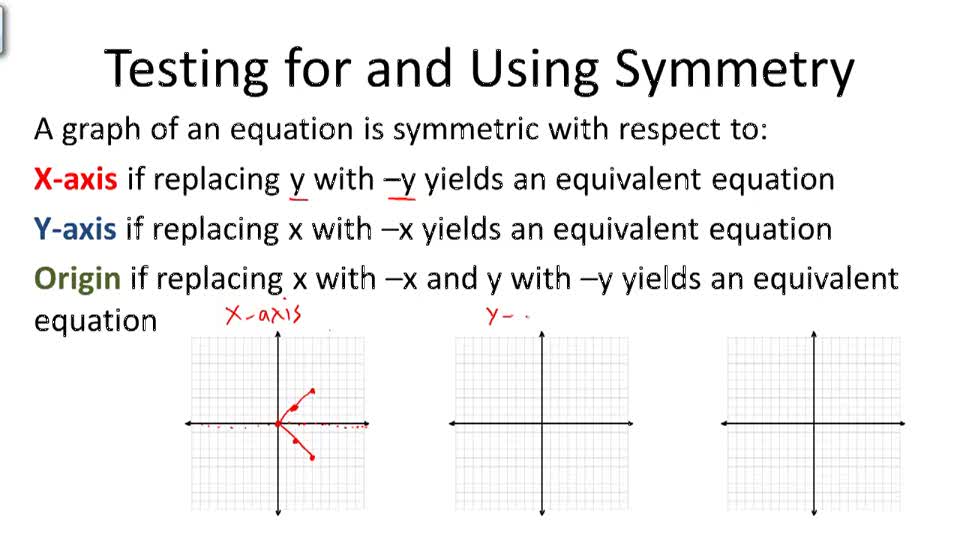
Even functions are symmetric about the y axis, odd functions are symmetric about the origin. Even functions: opposite inputs have the same input. Now lets draw tangent to two points on sin x :- ( / 4, 1 / 2), ( / 4, 1 / 2) Now the slope of tangent will be same for both the points only because graph of cos x is symmetric with respect to y axis so value of slope i.e. So remember odd functions: opposite inputs have opposite outputs. For better understanding assume that f ( x) sin x therefore f ( x) cos x. Now some examples from our parent functions are y=x, y equals x cubed and also y equals 1 over x. So it's 180 degrees symmetry about the origin. That means is you could take the the graph, rotate it 180 degrees and it will look exactly the same. Now, if this is true, the graph of an odd function would be symmetrical with respect to the origin. This means that opposite inputs give opposite outputs.
#ORIGIN SYMMETRY HOW TO#
Function f is odd if f of -x equals the opposite of f of x. Learn how to determine if graphs have symmetry with respect to the x-axis, y-axis, or origin, and see step-by-step examples to help improve your knowledge and understanding of the topic. There's y=x squared and there's y equals the absolute value of x. Now let's look at two examples from our parent functions. Available in a range of colours and styles for men, women. SYMMETRY BREAKING OF MOLECULES AND THE ORIGIN OF LIFE Seiji YUASA Department of Biology, College of General Education, Osaka University Toyonaka, Osaka 560. y equals f of -x is a reflection about the y axis, if the reflection of about the y axis of a function is exactly same the same as the function itself then it's symmetric about the y axis. Shop high-quality unique Origin Of Symmetry T-Shirts designed and sold by independent artists. Well, if you remember our discussion of symmetry, of reflections, the graph of y equals f of -x.

Matt said: 'The name of the album, Origin Of Symmetry, is from a book about geometry of the. Now what kind of symmetry does that give us? Well the graph of an even function's always going to be symmetric with respect to y axis. It discusses how a future book about the discovery of supersymmetry should be entitled 'The Origin Of Symmetry', due to its implications in physics, in reference to the explanatory impact Charles Darwins 'On The Origin Of Species' had on biology.2. Example 3: is 2xy 12 symmetric with respect to the origin Replace x with -x and y with -y in the equation. If you do get the same equation, then the graph is symmetric with respect to the origin. Origin Of Symmetry: XX Anniversary RemiXX has been remixed by Muse producer Rich Costey. With few exceptions, the shells (capsids) of sphere-like viruses have the symmetry of an icosahedron and are composed of coat proteins (subunits) a. with -y and see if you still get the same equation. It's been released to herald the release of Origin Of Symmetry: XX Anniversary RemiXX through Warner Records on June 18, to celebrate the twentieth anniversary of the band's second album, Origin Of Symmetry, widely regarded as the band's breakthrough album. That means that you can switch x for -x and get the same value. To check for symmetry with respect to the origin, just replace x with -x and y. Origin Symmetry Definition (Illustrated Mathematics Dictionary) A B C D E F G H I J K L M N O P Q R S T U V W X Y Z Definition of Origin Symmetry more. A function f is even if f of -x equals f of x for all x in the domain of f. See Sine and Cosine graphs for more properties of the sine and cosine graphs.I want to talk about even and odd functions. In general, for any even function f ( x ) f(x) f ( x ), the the graph of f ( x ) f(x) f ( x ) is symmetric about the y y y-axis for any odd function g ( x ) g(x) g ( x ), the graph of g ( x ) g(x) g ( x ) is symmetric about the origin. Since the function sin ( x ) \sin(x) sin ( x ) satisfies sin ( − x ) = sin ( x ) \sin(-x) = \sin(x) sin ( − x ) = sin ( x ), the graph of sin ( x ) \sin(x) sin ( x ) is symmetric about the origin. What is the symmetry satisfied by the graph of sin ( x ) ? \sin(x)? sin ( x ) ? But the origin of icosahedral symmetry in viruses, the validity conditions for the CK construction, and the physical principles underlying the quasi-equivalence principle have yet to be fully elucidated. Since the cosine function satisfies cos ( − θ ) = cos ( θ ) \cos(-\theta) = \cos(\theta) cos ( − θ ) = cos ( θ ), the graph of the function cos ( x ) \cos(x) cos ( x ) is symmetric about the y y y-axis. icosahedral symmetry have focused on the pathways and kinetics of the capsid formation process (18, 19). This shows the period of the tangent function is at most π \pi π.

The cosine and sine functions satisfy the following properties of symmetry:Ĭos ( − θ ) = cos ( θ ) sin ( − θ ) = − sin ( θ ).


 0 kommentar(er)
0 kommentar(er)
